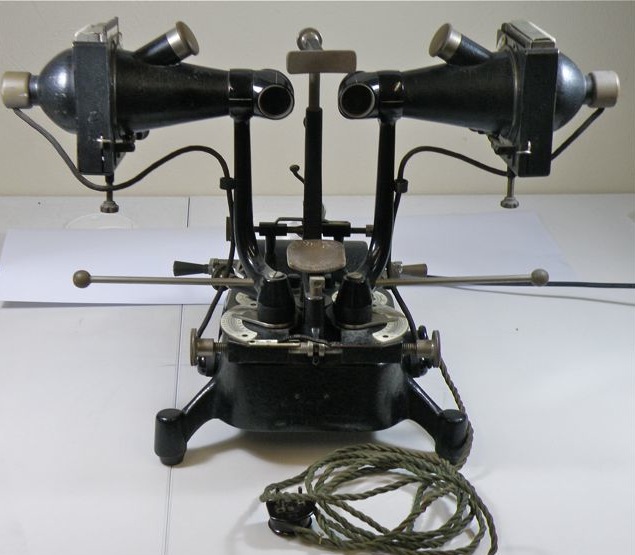Synoptophore for measuring and treating strabismus and other dysfunctions of binocular vision.
Catalogue Number: 2415 Synoptophore for measuring and treating strabismus and other dysfunctions of binocular vision. Category: Equipment Sub-Category: Synoptophore, stereoscope Year Of Publication/Manufacture: c 1930 Time Period: 1900 to 1939 Description Of Item: Synoptophore, 490 W x 300 D x 370 H, an instrument used for measuring and treating strabismus and other dysfunctions of binocular vision. Cast metal base, black crackle finish, with braided cloth covered electrical lead and three pin Bakelite plug, two rotating rheostats with scale for adjusting the voltage to the lamps and two push button switches are on the upper surface of the base. Two optical tubes each with a mirror and eyepiece are mounted on the base, each with a lamp housing lit by an electric lamp diffused by frosted glass, into which can be inserted glass slides to provide visual stimuli for visual training. The optical tubes can be rotated and the degree of rotation of each can be measured by white curved plastic scales. The separation of the optical tubes can be varied by a screw mechanism and measured with a scale to allow for differences in the separation of the two eyes. The lamp housings can be rotated around the axis of the optical tubes and the slides can be displaced vertically with a screw mechanism to allow for patients with cyclo- and vertical eye imbalances. There is a mechanism to yoke the rotations of the two optical tubes. There is also a mechanism to manually drive moving stimuli. The scale marker for separation of the tubes is marked with the patent number PAT No 38874-50. There are no maker's plate (lost?) or markings to identify the maker or model. Historical Significance: The fundamentals of modern methods of measuring and treating disorders of two eye co-ordination were laid down in the closing decades of the 19th century. Treatment involved eye exercises, which were time consuming. The discipline of orthoptics emerged in the early years of the 20th century to relieve oculists of the time consuming (and tedium) of orthoptic assessment and treatment. Instruments were developed to facilitate measurement and the eye exercises, the among the first of which was the Amblyoscope (Cat No 1130 and 1796) and the kinetic stereoscope (Cat No1554 and 1555). The synoptophore was a highly elaborated instrument, designed to do everything. This is an early example of the synotophore. It is similar to Howard synoptophore (Elliott Optical Company) and the Walter Green synoptophore (UK) held in the British Optical Association Museum. This instrument is probably the Walter Green synoptophore made by the Clement Clark Company. Condition: Good Location: Archive room. East wall Unit 1 Cupboard |


